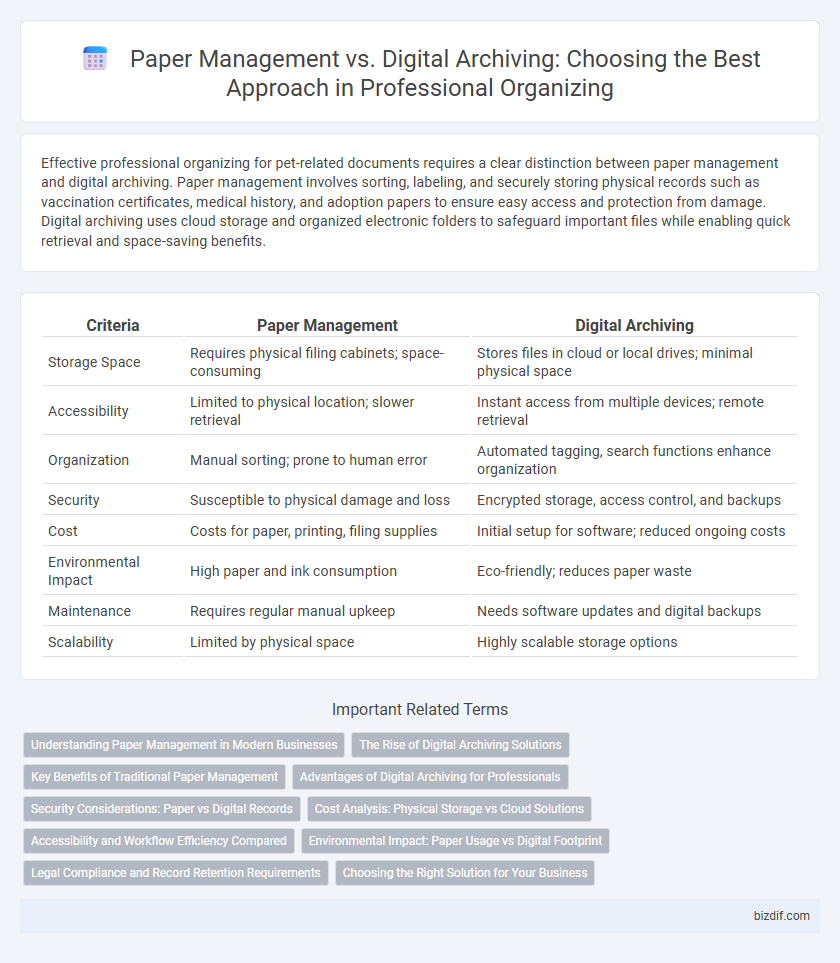Effective professional organizing for pet-related documents requires a clear distinction between paper management and digital archiving. Paper management involves sorting, labeling, and securely storing physical records such as vaccination certificates, medical history, and adoption papers to ensure easy access and protection from damage. Digital archiving uses cloud storage and organized electronic folders to safeguard important files while enabling quick retrieval and space-saving benefits.
Table of Comparison
| Criteria | Paper Management | Digital Archiving |
|---|---|---|
| Storage Space | Requires physical filing cabinets; space-consuming | Stores files in cloud or local drives; minimal physical space |
| Accessibility | Limited to physical location; slower retrieval | Instant access from multiple devices; remote retrieval |
| Organization | Manual sorting; prone to human error | Automated tagging, search functions enhance organization |
| Security | Susceptible to physical damage and loss | Encrypted storage, access control, and backups |
| Cost | Costs for paper, printing, filing supplies | Initial setup for software; reduced ongoing costs |
| Environmental Impact | High paper and ink consumption | Eco-friendly; reduces paper waste |
| Maintenance | Requires regular manual upkeep | Needs software updates and digital backups |
| Scalability | Limited by physical space | Highly scalable storage options |
Understanding Paper Management in Modern Businesses
Effective paper management in modern businesses streamlines document flow by categorizing, storing, and retrieving physical papers efficiently, reducing clutter and enhancing employee productivity. Properly implemented filing systems minimize time wasted on locating documents and ensure compliance with regulatory requirements. Integrating paper management with digital archiving solutions provides a hybrid approach, bridging traditional documentation with modern data accessibility and security.
The Rise of Digital Archiving Solutions
The rise of digital archiving solutions has revolutionized professional organizing by offering efficient, space-saving alternatives to traditional paper management. Digital platforms enable quick searchability, secure cloud storage, and seamless integration with productivity tools, enhancing accessibility and reducing physical clutter. Businesses increasingly adopt these solutions to streamline document handling, improve collaboration, and ensure compliance with data protection regulations.
Key Benefits of Traditional Paper Management
Traditional paper management offers tactile engagement that enhances memory retention and task prioritization. It provides immediate accessibility without reliance on digital devices or power sources, ensuring consistent availability. Physical documents reduce cybersecurity risks associated with digital data breaches, providing a secure option for sensitive information.
Advantages of Digital Archiving for Professionals
Digital archiving offers professionals enhanced accessibility and efficient retrieval of documents through cloud-based systems and searchable databases, significantly reducing time spent on manual paper management. It improves document security with encryption and regular backups, minimizing risks of physical damage or loss. Digital tools also streamline collaboration by enabling real-time updates and sharing across multiple devices and team members.
Security Considerations: Paper vs Digital Records
Paper records provide tangible security through physical locks and controlled access, reducing risks of hacking but increasing vulnerability to fire, theft, or loss. Digital archiving employs encryption, password protection, and cloud backups, enhancing data recovery and remote accessibility while exposing files to cybersecurity threats and unauthorized digital breaches. Optimal professional organizing balances these methods by implementing strict access controls and regular audits to safeguard sensitive information effectively.
Cost Analysis: Physical Storage vs Cloud Solutions
Physical storage of paper documents incurs ongoing costs for filing cabinets, office space, and maintenance, often leading to inefficiencies and the risk of damage or loss. Cloud solutions offer scalable storage with predictable subscription fees, reducing physical space requirements and enabling easy access and disaster recovery. Comparing both methods reveals that digital archiving typically lowers long-term costs while enhancing document security and retrieval speed.
Accessibility and Workflow Efficiency Compared
Paper management often hinders accessibility due to physical storage limitations and time-consuming retrieval processes, reducing overall workflow efficiency. Digital archiving enhances accessibility by enabling instant search and retrieval through cloud-based systems, streamlining document sharing and collaboration. Optimizing workflow efficiency relies on integrating digital tools that automate sorting, tagging, and secure storage, significantly reducing manual effort compared to traditional paper management.
Environmental Impact: Paper Usage vs Digital Footprint
Paper management relies heavily on physical resources, leading to deforestation, water consumption, and energy use during production, significantly contributing to environmental degradation. Digital archiving reduces reliance on paper but involves energy consumption from data centers and electronic devices, which produce a notable carbon footprint. Sustainable professional organizing balances minimizing paper usage with optimizing digital storage energy efficiency to reduce overall environmental impact.
Legal Compliance and Record Retention Requirements
Effective paper management ensures physical documents meet legal compliance through secure storage, proper labeling, and organized filing systems, minimizing risks of loss or unauthorized access. Digital archiving enhances record retention by enabling encrypted backups, easy retrieval, and automated compliance with regulatory timelines such as GDPR, HIPAA, or Sarbanes-Oxley. Balancing both methods optimizes adherence to legal mandates while improving operational efficiency and reducing the risk of penalties.
Choosing the Right Solution for Your Business
Effective paper management involves systematic sorting, labeling, and storing physical documents to ensure quick retrieval and compliance with regulatory standards. Digital archiving leverages cloud-based platforms and encryption technologies to safeguard data, enhance accessibility, and facilitate real-time collaboration across teams. Selecting the right solution depends on factors such as document volume, security requirements, budget constraints, and the need for remote access, guiding businesses toward either a streamlined physical system or a comprehensive digital archive.
paper management vs digital archiving Infographic

 bizdif.com
bizdif.com